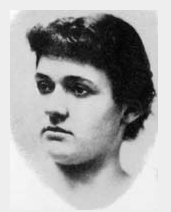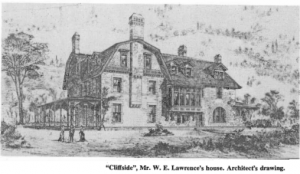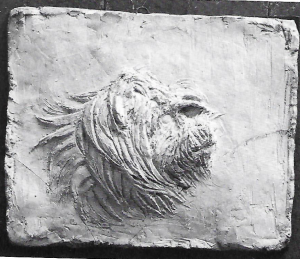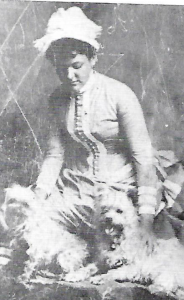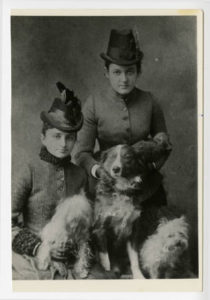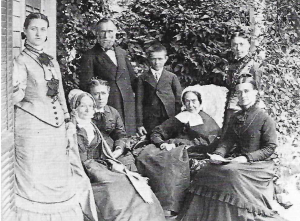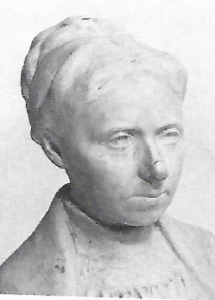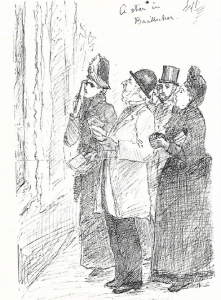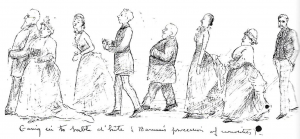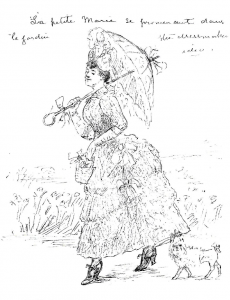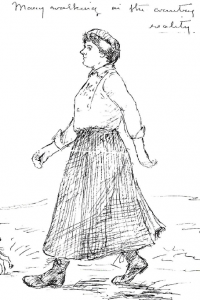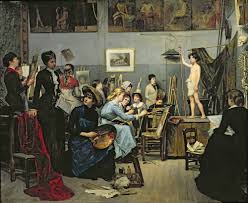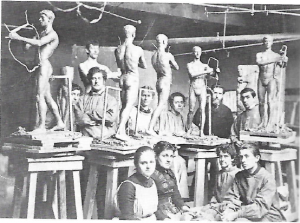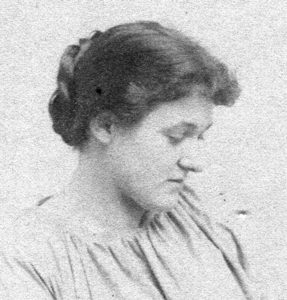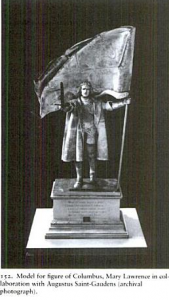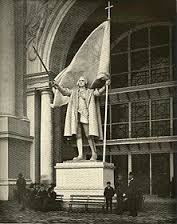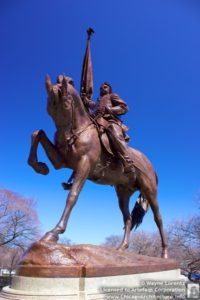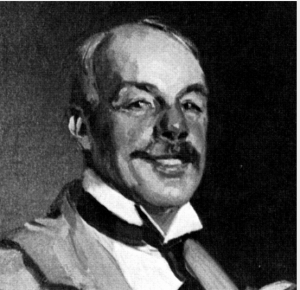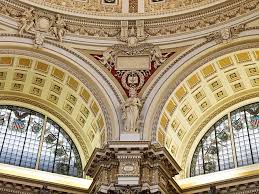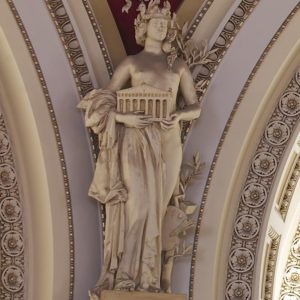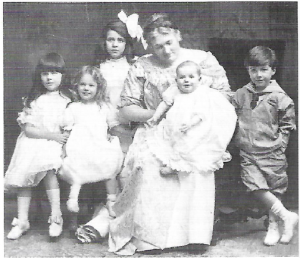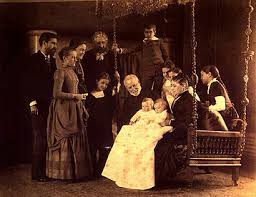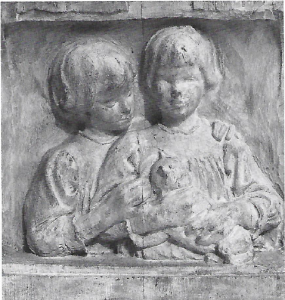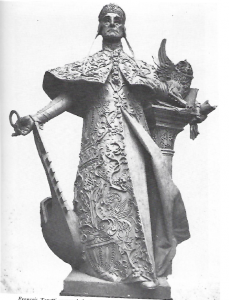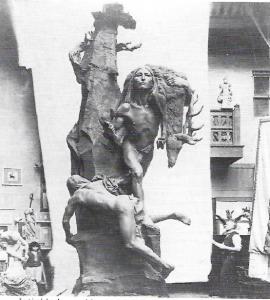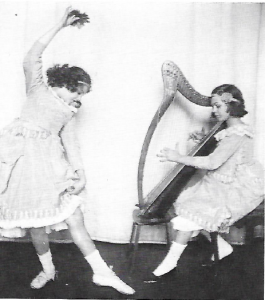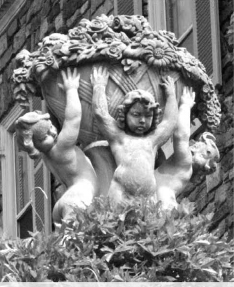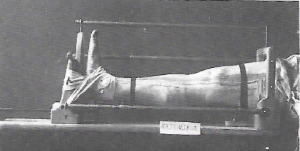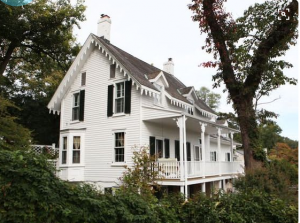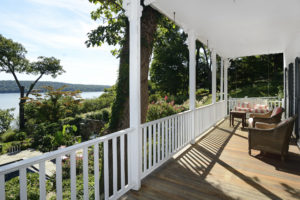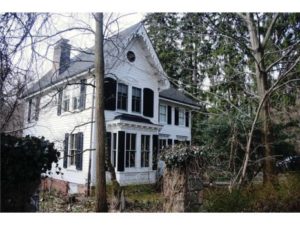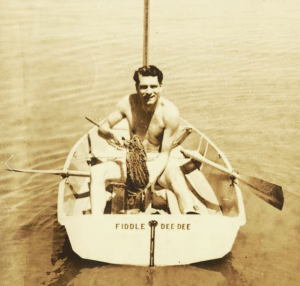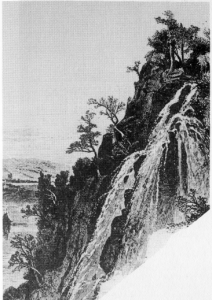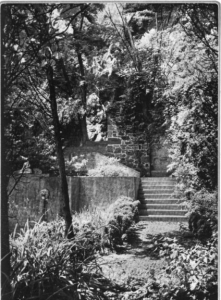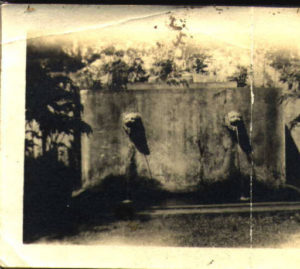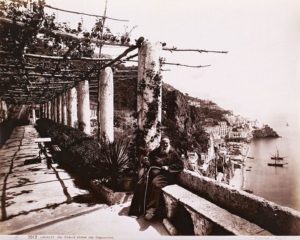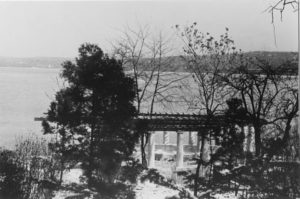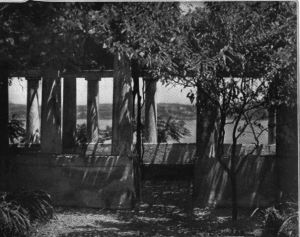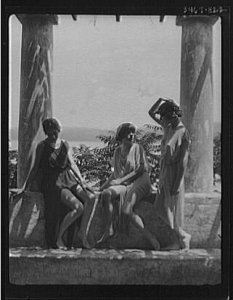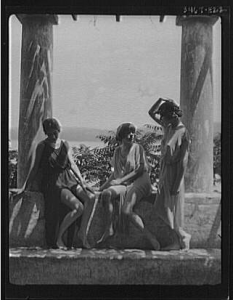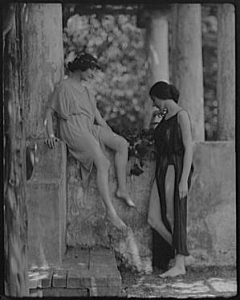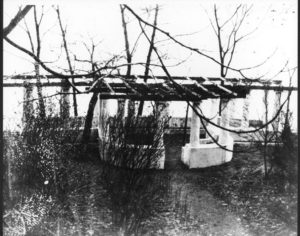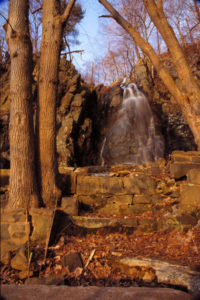Mary Trimble Lawrence, my wife’s third cousin three times removed, was born in December 1869 in New York, the daughter of Henry Effingham Lawrence and Lydia Greene Underhill. Her middle name came from her mother’s sister’s husband, Merritt Trimble. The Trimbles lived next door to the Lawrences on 25th St., and Mrs, Trimble. Annie Underhill, was Mary’s favorite aunt. The Lawrences attended Grace Church, where they sat in the pew behind the future Edith Wharton. Henry bought a farm, Arcadia, at Snedens Landing, opposite Dobb’s Ferry on the Hudson, a place that was to play an important role in his daughter’s life and indeed in artistic life to this day. There he built Cliffside.
The Lawrence family had a connection with the St. Gaudens because they bought their shoes from Bernard St. Gaudens, the father of Augustus. Augustus, when he was twenty-five, came to Snedens Landing to tutor children in drawing when Mary was seven; she may have been in his class. Mary converted a summer house on the property to her studio; her first sculpture, of her dog Dandy, survives.
Dandy
Mary with Friends
Mary and Anna and Friends
The Family at Snedens Landing
L to r: Edith Lawrence, Grandmother Underhill, Mrs Merritt Trimble, Merritt Trimble, Joseph Lawrence, Lydia Greene, Annie Underhill, Mrs. Henry E. Lawrence
Aunt Ann by Mary
The family encouraged her work, and in 1886-1887 did the Grand Tour with sister Edith and her aunt, Annie Underhill, who lived next door on 25th St. Mary illustrated her travel journal.
Mary was amused by those who knew what to admire because it had a star in the Baedeker.
She observed the parade of humanity at the grand hotels
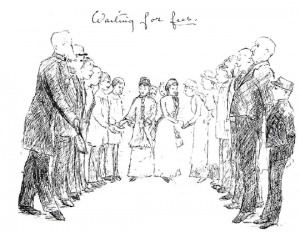
and had to run the gauntlet at hotels.
In Paris she visited a dressmaker who had her own ideas of what a wealthy young women should wear while strolling.
Mary, having grown up much of the time in the country, had her own ideas of what walking clothes should be.
She returned home briefly and then in April 1887 entered the Academie Julien in Paris (the Ecole des Beaux-Arts did not accept women until 1897). Within a week of her arrival in Paris, Mary Lawrence was invited to Auguste Rodin’s art studio which he shared with his student and young mistress Camille Claudel. Together they strolled through the studio where Mary got to see the models for The Burghers of Calais and some of the figures from The Gates of Hell.
The Studio by Académie Julian student Marie Bashkirtseff.
Mary studied at the Academie until the summer of 1888 when she began teaching under St. Gaudens at the Art Students League in New York. In 1890 plans for the Columbia Exhibition in Chicago began, and in the fall of 1891 St. Gaudens asked Mary, only twenty-three years old, to do the main statue of Christopher Columbus.
The Art Students League
Mary is seated, second from left.
St. Gaudens is standing, second from right.
Mary in a work smock
The Model
The Court of Honor
Frank Millet, a fair organizer, objected to the prominent placement of the statue and arranged to have it moved to a spot near the train station. The architect Charles Follen McKim, who had fallen in love with Mary in New York, had enough sway in Chicago to get the statue of Columbus returned to its former place. Lawrence never forgave Millet and is quoted as saying, “I could stamp on his face and grind it into the gravel until it bled.” St. Gaudens said that “Miss Mary Lawrence, now Mrs. François M. L. Tonetti, modeled and executed it; and to her goes all the credit of the virility and breadth of treatment which it revealed.” The statue was executed in staff (a temporary artificial stone), and like much of the art for the Exhibition, no longer exists. Mary then helped St. Gaudens with the General John A. Logan monument for Grant Park in Chicago.
General Logan Monument, Chicago
She returned to the Academie Julien in December 1893 to continue her studies. Charles Dana Gibson (also a distant relative of my wife’s) gave a ball, where Mary met François Tonetti. She encountered him again at James Whistler’s home at 110 rue de Bac.
François Michel Louis Tonetti
François’ grandfather moved to Paris and opened a marble shop because in Genoa he had beaten to death his wife’s lover, a priest. He therefore found it expedient to use someone else’s passport and name, Sr. Dozzi, so sometimes the Tonettis were known as the Dozzis.
Tonetti had a dreadful childhood. He was born in Paris in 1864; his father died when he was about six. His mother took in laundry to support him and his two sisters, but during the siege of Paris in 1870-1871 she and his sisters died of starvation. François survived by begging.
After the war François’ grandfather took him into the marble shop. A member of the French Academy visiting the shop saw a statue François had done and invited the boy to move in with his family. There he was exposed to artists and writers. When he was old enough he was sent to the Ecole des Beaux-Arts. After school François became an assistant to sculptor Frederick MacMonnies who had been an early assistant to Augustus Saint-Gaudens.
Mary returned to New York in September 1894. There she worked with St. Gaudens and when he moved to Paris she took over his classes at the Art Students League.
When he met Mary, François was working on a 10 1/2 foot plaster sculpture representing Art, one of eight figures created for the Main Reading Room of the Library of Congress.
François, who was taken with Mary, persuaded Monnies to send him to New York to assist with the completion of sculptures for the Brooklyn Memorial Arch on Grand Army Plaza.
Mary and François were engaged in 1899. St. Gaudens was delighted. He wrote to Mrs. Lawrence:
I never knew two people more made for one another, and that they should have been brought together is a smile of fortune. Besides the qualities that befit him peculiarly for Mary, he is a most affectionate and loveable man…I know they will be happy together.
They married in 1900 at Grace Church; she was thirty-two and he thirty-six. They moved into the former Murray Hill Presbyterian Church (where the Rum, Romanism, and Rebellion sermon was preached) at 135 East 40th Street that they had converted into a home with a spacious studio. Summers and weekends were spent at Snedens Landing. They had six children: Oliver Pellier, who died a few days after in birth in July 1901; Ann Elizabeth (1903-1990), who married the architect Eric Gugler; Lydia Lawrence (1904-1943), who married Robert McKee Hyde; Joseph Lawrence (1905-1963), who married Susan McKee Hyde, the sister of Robert; and Marie Françoise, also known as Chrissie because of her December birth (1907-1972), who married first John Drury Ratcliff and then Allan B. Sheldon; and Alexandra (1909-1991), who married Harwood A. White.
Mary and the children
The Tiffany Twins Immortalized in Manhattan
Louise and Julia Tiffany and Admirers
About 1900, judging from the age of the models, Mary did a sculpture of Louis Comfort Tiffany’s twins, Louise Comfort and Julia DeForest. Katherine Cornell, the actress, who had a house at Snedens Landing apparently liked the sculpture so much that when she moved from Snedens Landing in 1965, Mary’s daughter Anne Gugler gave the sculpture to her as a housewarming present. Cornell installed it over the door at her new residence at 328 East 51st St., where it can be seen today.
The Tiffany Twins, reproduction in wood
Mary and François, along with Chester French, Saint-Gaudens and a number of other sculptors, were chosen to create statues for the façade of the U.S. Custom House at Bowling Green and Broadway designed by architect Cass Gilbert (now the National Museum of the American Indian). François sculpted the Doge as a representation of Venice and Queen Isabella personifying Spain. He used Mary’s mother as a model for the Doge’s imperious head.
Venice
Mary collaborated on this as well as on the “Birth of Venus” fountain in 1901 for the Pan American Exposition in Buffalo.
François was inspired by the rugged beauty of the Palisades to do a sculpture of American Indian Life: a twenty foot high statue of two Indians, one carrying a dead deer. François’s attempt at realism gives an idea of the tenor of life at the Tonettis’ studio:
To model the deer, François borrowed a fine stag from his friend, Dr. William T. Fornaday, director of the Bronx Zoo, who sent the animal to him in a cage. As it arrived on a hot day and seemed overcome by the heat, François thought it would be more at ease if released from the cage. Once outside the bars, however, the stag ran amok, butted over and smashed things generally in the studio and created havoc, until François, in real terror, seized a shotgun and killed it. Then, thrifty Frenchman that he was, he walked around the corner to his friend the butcher for help in skinning it and carving it up. Mary, meanwhile, arrived back at the studio, found it a bloody mess, with the stag dead in the middle of the chaos and no François, and was herself reaching the panic stage when he walked in happily with the butcher. Together they skinned and quartered the animal and removed it.
François paid the zoo for the stag, and was fined by the investigating police for shooting dear out of season, but for days there was venison at the studio…and his girls, that winter, had intriguing new coats with deerskin collars, miffs, and cuffs. (Savell)
Mary was also interested in the dance. She took Ann (who had a career in the theater) and Alexandra to see Isadora Duncan at the Met, and the girls were stagestruck.
Alexandra on left and Chrissie (Marie) on right
They attended Elisabeth Duncan’s School of the Dance where they associated with Maurice Stern, Pablo Casals, Mabel Dodge Luhan, Gertrude Stein, and of course Isadora. They became Isadorables, and toured Europe in a dance troupe.The Tonettis gave many and large parties; and Mary’s status as a Lawrence assured that invitations were coveted. In 1909 Mary hosted “Une Heure de Danse” at her studio for the benefit of a dancing class for shopgirls. Society members danced :Japanese, Egyptian, Sicilian, and Spanish dances.” The New York Times listed various relatives and acquaintances of my wife’s family: Leonie Alexandre (first cousin) did a Spanish dance; Robert Potter Breese (eighth cousin) did a “buck dance” and an Irish jig; Harvey Ladew (a hunting companion of my wife’s uncle) did a clog dance. Miss McLaughlin “gave a humorous recitation of Salome.” The children were nonplussed by all this. As they grew up in an artists’ studio which often had models in various stages of nudity, they assumed everyone had people walking around naked in their houses.
The staff that took care of the house and five children were varied: an Irish cook; a useful handyman given to benders; Siegfried, a doorman who had been a giant in Barnum’s circus; Siegfried’s Swedish wife; and an Indian prince who studied calculus.
Mary also helped found the Cosmopolitan Club. It began as a club for governesses, who were not interested, so literary and artistic types took it over. Mary installed it in townhouses adjacent to her studio.
François’s life was to be drawn into the events of the great world and prematurely ended,
When John D. Rockefeller, Sr.’s Kykuit was built at Pocantico Hills, François did a number of pieces for the house and grounds. Several years later in 1913 when the façade was changed, he was commissioned to design and execute a pediment that runs across the front facade and two groupings of four cherubs holding baskets of flowers that now stand on either side of it atop side balconies. The Tonettis’ youngest daughter Alexandra was the model for the angelic figures.
Mary finished the figures and oversaw the installation; François, feeling it his duty, had left to serve in the French Army in the First World War as a doctor’s aide.
Among other duties (one involved drawing wounds in color so doctors could judge how they were healing), he used his knowledge if anatomy and the transport of statues to design a brace to allow wounded soldiers to be moved safely.
While in France he contacted pneumonia and returned in ill health at war’s end, dying in 1920 at the age of fifty-six. His last work was a plaque in honor of the Best & Co. employees who served in the First World War.
When Mary sold the Manhattan studio she had a number of his works (including the Indians with Deer) brought out to Snedens in the dead of night, had a hole dug and the sculptures buried.
Snedens Landing
At Snedens Landing Mary built and rented out a variety of houses on her property to artistic friends, thereby permanent stamping the place as an artists’ colony.
Ding Dong House today
View of Hudson from porch of Ding Dong House
She lived first in the Ding Dong House, so called because of a bell that hung at the entrance gate. Aaron Copland later lived there, as did Uma Thurman and Ethan Hawke, Jerome Robbins, and Margot Kidder
Many famous and forgotten artists and celebrities have lived in Snedens Landing: Ethel Barrymore, Marcel Duchamp, John Steinbeck, Ginger Rogers, Noel Coward, Orson Wells, Jerome Robbins, Peter Seegar, John Dos Passos, Mikhail Baryshnikov, Al Pacino, Diane Sawyer, Bill Murray, Björk, Phish Frontman Trey Anastasio, Lorraine Bracco, Bill Murray,Uma Thurman, Ethan Hawke, Angelina Jolie Pitt, Hayden Panettiere etc. Laurence Olivier and Vivien Leigh lived in the Captain Coastes House; they sailed in a little boat called Fiddle-Dee-Dee; they left it to the town and children continued to sail the Hudson on it.
Captain Coates House
Laurence Oliver on the Fiddle Dee Dee
But Mary rented the houses out for a pittance, $15 a month to start, so she could have creative types around her. After the Cosmopolitan Club moved uptown she mortgaged her properties on 40th St. to pay for remodeling. But in the Depression she lost all the Manhattan properties and retired to Snedens Landing. There she had her gardens.
The Gardens
The Lawrence property included a waterfall, “The Cascade.”
The Cascade
Guest would arrive at Dobbs Ferry, be taken across the Hudson, and stroll to the Cascade where violins and dancers greeted them. Tonetti’s specialty party dish was new and exotic: spaghetti.
Her grandson John Ratcliff describes the gardens:
In the early 1920’s, my grandmother, Mary Lawrence Tonetti, a talented sculptress of the era, designed and built two swimming pools at the base of the waterfall. There was a children’s pool, which when filled, water would cascade over into the larger adult pool adjacent to it. On the Hudson River’s edge, she built an oval-shaped pergola. Arriving at the waterfalls by a path through the woods, one would first come to the two pools, descend a series of staircases to a gravel walkway lined with boxwood hedges and daylily plantings. At the base of the staircase one would pass a fountain with two lions head spigots she had sculpted, that were fed by the pools above and would spew water into the fountain. Proceeding down the path, one would enter the pergola which had columns all around it that supported several grape vines that would bear grapes during the summer.
Lions’ Head Fountain
Mary had admired a monastery on the Amalfi coast when she was on her Grand Tour.
Charles McKim assisted her with the design of a pergola supporting a grape arbor.
It was irresistible as a site for eurythmic dancing.
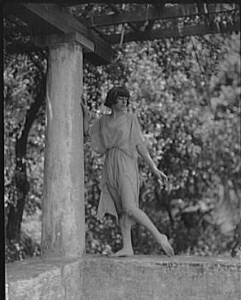 \
\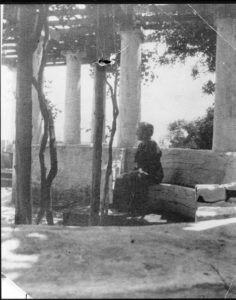 Mary is sitting in the pergola in the 1940s.
Mary is sitting in the pergola in the 1940s.
Mary died at Snedens Landing on March 14, 1945.
Time and vandals took their toll of the gardens. The Cascade is still there.
Hurricane Sandy toppled the last of the pergola’s pillars.
Sources: Isabelle Savell, The Tonetti Years at Snedens Landing, Mary Tonetti Dorra, Demeter’s Choice: A Portrait of My Grandmother as a Younmg Artist.
